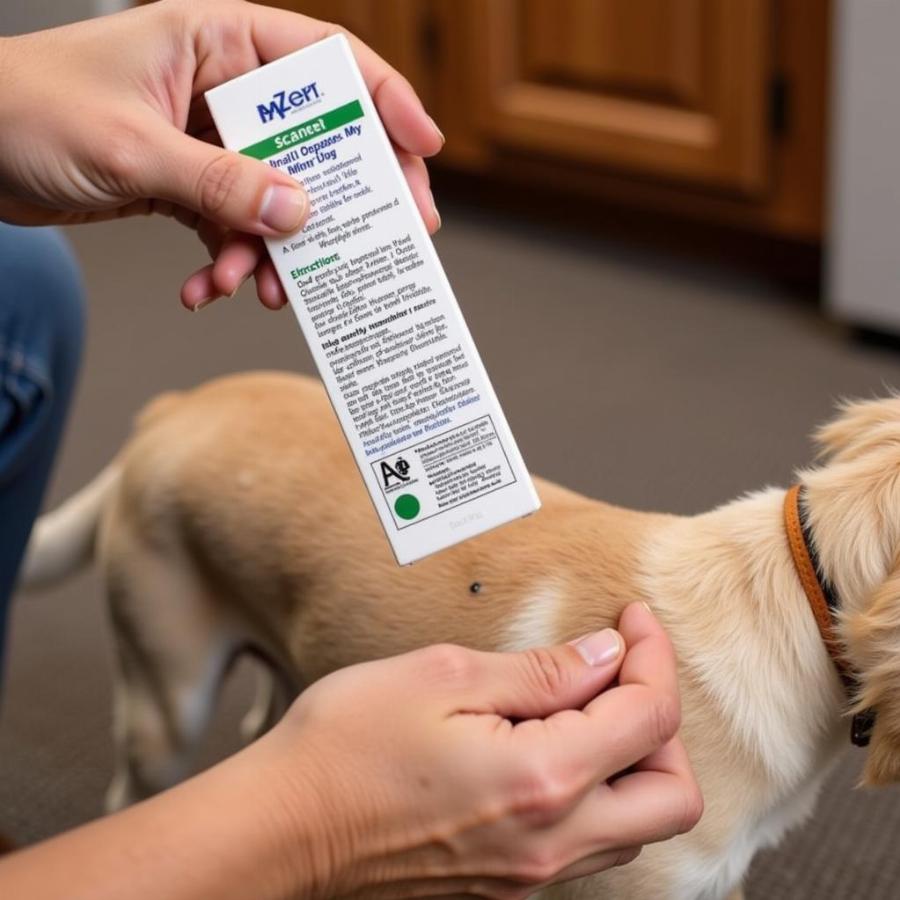Flea dirt on your dog is a telltale sign of a flea infestation. This dark, gritty substance isn’t actually dirt, but flea feces composed of digested blood. Learning how to identify and eliminate flea dirt is crucial for your dog’s comfort and health. This guide provides a comprehensive approach to tackling flea dirt, ensuring a flea-free environment for your furry friend.
Identifying flea dirt is the first step. It looks like small, dark specks, often resembling ground pepper. If you’re unsure, try the wet paper towel test: place some of the suspected flea dirt on a damp white paper towel. If it’s flea dirt, it will dissolve and leave a reddish-brown stain due to the blood content. This simple test can confirm the presence of fleas and prompt necessary action. Addressing the infestation quickly prevents further discomfort for your dog and avoids the spread of fleas to your home.
Effective Flea Dirt Removal Techniques
Once you’ve confirmed flea dirt, it’s time to take action. Start with a thorough bath using a flea shampoo specifically designed for dogs. Follow the instructions carefully, paying close attention to contact time. A flea comb is an invaluable tool for removing flea dirt and even live fleas during the bath. Work the comb through your dog’s fur, dipping it frequently in soapy water to remove the debris.
After the bath, thoroughly dry your dog. Regular brushing can further help remove any remaining flea dirt and keep their coat healthy. Remember to wash all bedding, blankets, and any other areas where your dog frequently rests. Hot water washing and high heat drying are crucial for killing fleas and their eggs.
Preventing Future Flea Infestations
Preventing future flea infestations is just as important as treating existing ones. Regularly using a flea preventative treatment, as recommended by your veterinarian, is essential. These treatments come in various forms, including topical solutions, oral medications, and collars. Choosing the right one depends on your dog’s lifestyle and preferences.
 Applying Topical Flea Treatment to a Dog
Applying Topical Flea Treatment to a Dog
Keeping your home clean also contributes to flea control. Vacuum regularly, paying particular attention to areas where your dog spends most of its time. Empty the vacuum bag immediately after each use to prevent fleas from escaping. Washing your dog’s bedding and blankets frequently in hot water also helps eliminate fleas and their eggs.
What Causes Flea Dirt on Dogs?
Flea dirt is a direct result of a flea infestation. Fleas feed on your dog’s blood, and the digested blood is excreted as flea dirt. These tiny, dark specks are a clear indication that your dog has fleas. Ignoring flea dirt can lead to various health issues for your dog, including skin irritation, allergies, and even anemia in severe cases.
Home Remedies for Flea Dirt Removal
While commercial flea treatments are generally recommended, some home remedies can help manage flea dirt. For example, a mixture of apple cider vinegar and water can be sprayed on your dog’s fur after a bath to repel fleas. However, it’s important to consult your veterinarian before using any home remedies, especially if your dog has sensitive skin. Homemade remedies should not replace vet-recommended flea prevention and treatment. They can complement traditional methods but shouldn’t be relied upon solely. Similar to [homemade remedies for fleas on dogs], these solutions offer a supplementary approach. Thinking of getting your dog a new blanket? Consider our guide on [blankets for dogs] for some helpful tips.
Conclusion
Dealing with flea dirt requires a proactive and thorough approach. Regular bathing with flea shampoo, consistent use of flea preventatives, and maintaining a clean home environment are key to keeping your dog flea-free and happy. Remember, early detection and consistent effort are crucial in winning the battle against these pesky parasites. Don’t let flea dirt take over your dog’s life. Take action today to ensure a comfortable and healthy environment for your beloved companion. If your dog has fleas and sleeps in your bed, this could be a problem. You can learn more about this issue in our article: [dog has fleas and sleeps in my bed]. We also have a helpful resource on [flea photos on dogs] to help you identify the signs of an infestation. You can find more information on how to get rid of all types of parasites here: [how do you get rid of parasites in dogs].
FAQ
- What does flea dirt look like? Flea dirt appears as small, dark specks resembling ground pepper.
- How can I confirm it’s flea dirt? The wet paper towel test is a reliable way to confirm flea dirt. The dirt will dissolve and leave a reddish-brown stain.
- What should I do if I find flea dirt on my dog? Bathe your dog with flea shampoo, use a flea comb, and consult your veterinarian about preventative treatments.
- How can I prevent flea infestations? Regular flea preventative treatments and maintaining a clean home environment are essential.
- Are home remedies effective for flea dirt removal? Some home remedies can help, but they should not replace vet-recommended treatments.
- Can flea dirt harm my dog? Yes, flea dirt can cause skin irritation, allergies, and even anemia in severe cases.
- How often should I bathe my dog with flea shampoo? Follow your veterinarian’s recommendations, as overuse can dry out your dog’s skin.
Beaut Dogs is your ultimate resource for all things related to show dogs, offering expert advice, insightful guides, and a comprehensive understanding of these magnificent breeds. We provide detailed information on various aspects of dog ownership, from breed selection to health care, nutrition, training, and grooming. When you need assistance, contact us at Email: [email protected] for detailed and accurate answers from Beaut Dogs. Visit https://beautdogs.com today!